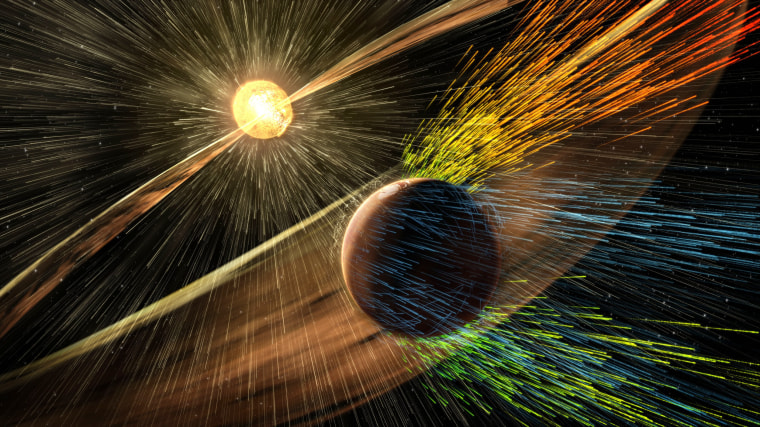Scientists think Mars may have been a warmer, wetter planet billions of years ago — until something catastrophic happened to its atmosphere. On Thursday, researchers presented new findings that hint at how the Red Planet may have gone from a more life-friendly world to the apparent wasteland we see today as nearly all of the planet’s air was stripped off into space.
Drawing from data collected by the Mars Atmosphere and Volatile Evolution (MAVEN) mission, teams from NASA and universities around the world reported on how intense bursts of gas and electromagnetic energy from the sun could have ripped away the atmosphere that cloaked young Mars. The studies also investigated other interactions between the planet and solar winds, and an aurora over the planet similar to Earth’s northern lights.
Read More: Mars Shows Strong Signs of Flowing Water, Researchers Say
The scientists presented their research in a collection of studies, four of them published in the journal Science, and another 44 papers in Geophysical Research Letters.
"Understanding what happened to the Mars atmosphere will inform our knowledge of the dynamics and evolution of any planetary atmosphere," John Grunsfeld, NASA associate administrator, said in a statement. "Learning what can cause changes to a planet’s environment from one that could host microbes at the surface to one that doesn’t is important to know, and is a key question that is being addressed in NASA’s journey to Mars."

One study looked at how interplanetary coronal mass ejections — fast-moving gusts of solar material spat out by the sun — may have helped whittle the ancient Martian atmosphere over many millions of years down to what it is now, about 1 percent of Earth’s. By looking at an ICME that struck Mars in March of this year, scientists observed a greater quantity of gas ions being shot into space — something that could have happened more frequently when the solar system was younger and the sun more active.
"Given the likely prevalence of ICME-like conditions earlier in solar-system history, it is possible that ion escape rates at that time were dominated by storm events," the authors wrote in one of the studies published in Science. "As these early periods may have been the dominant times at which the Martian atmosphere experienced loss, the inferred climate change on Mars may have been driven to a large extent by these solar storms."
Mars' atmosphere may have been especially vulnerable to these solar blasts because the planet, unlike Earth, does not have a strong magnetic field to ward them off.
Read More: NASA Needs Grip on Mars Health Hazards, Report Says
Previous findings from the Curiosity rover had suggested that Mars had lost most of its air more than 3 billion years ago, making life as we know it more difficult on the planet. More recent studies have found possible evidence of what may still be flowing water on the surface of Mars. The new answers revealed in Thursday's studies may also point to where all that water could have gone.
"When we look at ancient Mars, we see a different type of surface, one that had valleys that look like they were carved by water, lakes," said Bruce Jakosky, the principal investigator for the MAVEN mission. "The atmosphere must have been thicker at that time in order to sustain a warmer climate."
The $670 million MAVEN mission launched two years ago and has been in orbit around Earth’s neighboring planet since September 2014. The craft carries a set of instruments designed to fulfill its main mission, to study Mars’ upper atmosphere.
NASA has proposed a plan to send humans to explore Mars by the 2030s.
